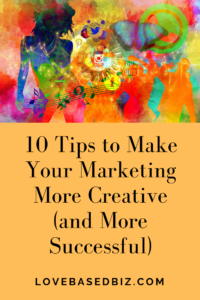Let’s face it: when it comes to marketing, the “same old, same old” just doesn’t cut it anymore.
To make your marketing stand out (resulting in more sales of your product and/or service), you need to get creative.
Keep reading for ten tips to get your creative juices flowing. (Some of these are brainteasers, or what Thinkertoys author Michael Michalko calls “Linear Thinkertoys.” Others are intuition based, or “Intuitive Thinkertoys.”)
Note: Even though some tips may appeal to you more than others, I strongly suggest trying them all. You just never know what will open a door for you!
Tip 1. Keep your inner critic quiet.
As obvious as this one may seem, many people struggle with it. When exploring creative possibilities, put a gag over the mouth of your inner critic. While there is certainly merit in critiquing your ideas at some point, brainstorming sessions are meant ONLY for idea generation. So let your inner critic know his time is coming, but for now, he needs to keep quiet. If he still doesn’t listen, tell him to go watch a Game of Thrones episode.
Tip 2. Find the “second right answer.”
Roger von Oech talks about this in his book, A Whack on the Side of the Head. The idea here is to not call it quits after reaching that first “good idea.” Take the time to think of a second, or third, or 50thidea.
Quantity does count, here. The more ideas you have to choose from, the more likely you’ll discover a brilliant one. (Remember, Thomas Edison discovered around a thousand ways a light bulb didn’t work.)
Tip 3. Change the question.
Changing the question you’re asking will often provide you with a different answer. For example, if you want to sell more, you’re probably asking yourself, “How can I sell more of my product?”
What might happen, though, if you changed that question to “How can I make more money?” Your thinking will shift, because now, you’ve opened up some new doors around different ways to make money. Maybe you lower your production cost. Maybe you raise your prices. See how this simple tactic can present new avenues to explore?
Tip 4. Reverse the question.
So, if we go back to the “How can I sell more of my product” question, what would happen if we reversed it?
What if we asked ourselves, “How do I NOT sell more products?”
Why would we even ask such a question? Well, maybe it’s too much work for you to produce even more. Maybe you even want to sell fewer products, to keep your cost down.
So, what if we asked ourselves “How do I make more money by selling fewer products?” Some of the answers you get might include looking at ways to increase your profit margin. Or maybe you focus on selling to a more targeted group of people, thus increasing your sales conversion. Again, this is about “jolting” your thought processes into different directions.
If you really want to play around with your creativity, try reversing the question so it’s really silly. For example, instead of “Why can’t I make more money,” try “Why would I want to lose money?” See what ideas you come up with—you may surprise yourself.
Tip 5. Look at a different industry.
Let’s say you’re a self-help author. Instead of focusing only on how personal development experts market, pick up a computer magazine. Look at the ads. How are computers sold? Can you use any of those tactics to sell your book? How would you sell your book to that audience?
Taking two dissimilar ideas and combing them into a new, original idea is super creative, and could act as the springboard to an entirely new, creative marketing campaign.
Now, let’s move into the more intuition-based techniques.
Tip 6. Ask your product or service how it wants to be sold.
Start by getting yourself into a relaxed state. Take a few deep breaths, or practice some relaxation techniques.
Next, imagine your product or service in front of you. Ask it questions like these: Who do you want to be sold to? How do you want to be sold? What are your strengths? What are your weaknesses? Who do you think you can help? Why do you want to help them?
This can also be a journaling exercise. Be sure to write down each question and answer, and see what bubbles up onto the paper.
Tip 7. Imagine yourself as your product.
How would you want to be sold? Again, start by going through a few relaxation exercises to quiet your mind.
Then, as you imagine yourself as your product or service, answer the following questions: What do I do in my spare time? What websites do I visit? Who are my friends? Who do I want to help? Who do I want to be sold to? How do I want to be sold? I recommend writing down your answers, so you can revisit them later.
A word of caution, here. Tips 6-7 can be a little tough. It’s not always easy to shift your mindset. But the exercises I’m recommending can be very powerful, so try not to throw in the towel if you feel discouraged at first. It’s very possible that you end up with some amazing insights about your product and the selling process that you have never considered before.
Tip 8. Sleep on it.
Some experts believe that dreams are messages from your subconscious (or your intuition/gut/muse … whatever you call it). This tip can help you harness that power.
Put a notebook and pen next to your bed. Before you go to sleep, fix the question you want to ask your subconscious in your mind.
Here are a few examples to get you started: How can I sell more products and services? How can I build my business? How can I better reach my target market? What marketing techniques would work best for me? What products or services would help my target market?
Repeat the question a few times before you drift off. Then, in the morning, before you fully wake up, write down as much as you can remember about your dreams in the notebook. (Don’t remember dreams, specifically? Write down any impressions, images, words, emotions, etc. that are fresh in your mind.)
With this tip, please don’t expect to open your eyes to an immediate “ah-ha, that’s the answer” type of epiphany. In fact, don’t be surprised if you’re more puzzled than you were before. Your subconscious often communicates via imagery, and it may take a few days before you start seeing a pattern. Or, you might find yourself washing dishes or driving to the store when the answer suddenly hits you … and on the surface, it may not appear to have anything to do with your dreams at all.
Over the years, I’ve found my subconscious to be a helpful, albeit sometimes confusing, guide. Whenever I’ve asked for guidance, I’ve always received an answer, even if it took me awhile to figure out the meaning. You can also ask your subconscious for help in deciphering its answer. Many times, you will receive additional guidance.
Tip 9. Paint a public relations campaign.
What would a press release look like if you painted it? Or sculpted it? How about a dance number? A collage
Take any part of your marketing that troubles you and turn it into a piece of art. By combining two dissimilar things, you may discover your answer. Or, you may not come up with anything at all, but just the act of “playing” and “creating” could jolt something loose. Hours or days later, your idea may suddenly pop right up in front of you.
Tip 10. Walk away.
If nothing is working, then stop. You can literally walk away by taking a walk, or just quit thinking about it altogether. This is especially important if you find yourself getting frustrated or discouraged. Give your subconscious time to mull things over. The idea will come when you are ready to receive it. Or, after a few days, try another exercise or two. Any one of these might end up the catalyst you’ve been waiting for.
BONUS TIP:
And this one’s the most important tip of all …
Make sure you have a blast! Being creative should be FUN. Keep it light, and don’t let yourself struggle too hard with it.
Go through as many of these tips as you can, and see how many ideas you’re rewarded with.
If you like this article, you may also enjoy my Love-Based Online Marketing book.

 The Importance of Personality Part 2: Let’s Add It to Your Writing
The Importance of Personality Part 2: Let’s Add It to Your Writing The Importance of Personality Part 1: Is Your Website Dreadful?
The Importance of Personality Part 1: Is Your Website Dreadful? 4 Ways to Creatively Power Up Your Marketing
4 Ways to Creatively Power Up Your Marketing Quiz: Where Is Your Marketing Message Hanging Out?
Quiz: Where Is Your Marketing Message Hanging Out? Need Some New Ideas? 3 Ways Journaling Boosts Creativity
Need Some New Ideas? 3 Ways Journaling Boosts Creativity
Leave a Reply